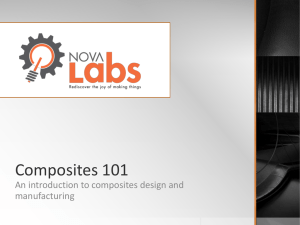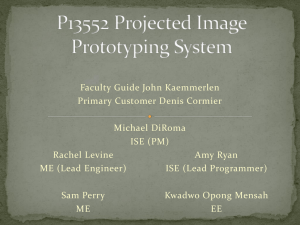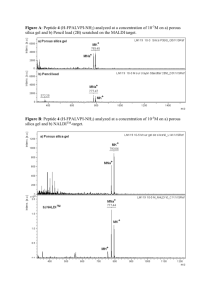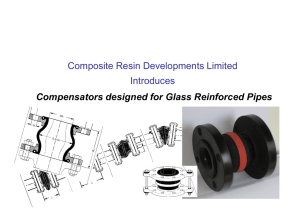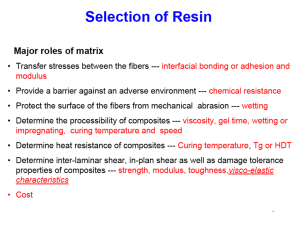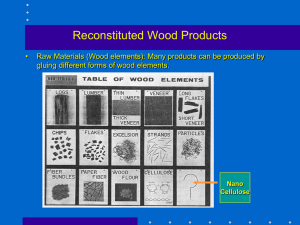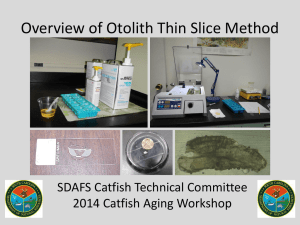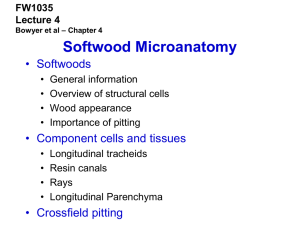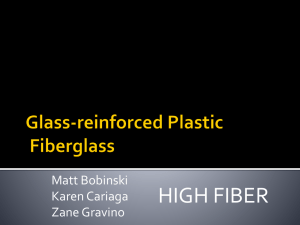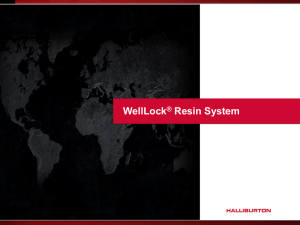Prosthetics Research Specialists, Inc 720 East Southland Ave
advertisement
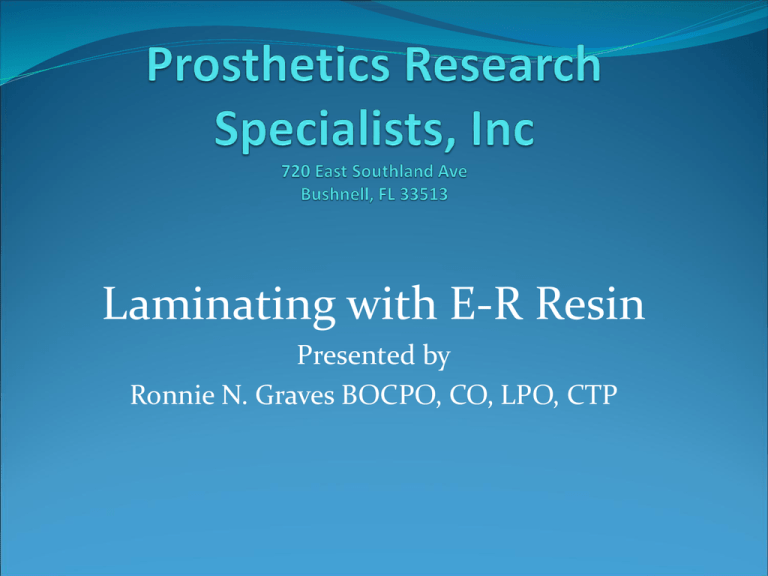
Laminating with E-R Resin Presented by Ronnie N. Graves BOCPO, CO, LPO, CTP This is what comes in the box E R Resin The only resin capable of creating a sealed socket for use in Elevated vacuum environments. Creates a smooth inner surface and a smooth outer socket if worked with properly With no need for Carbon, it can create a heat relievable socket for you. Can be laminated directly over with no roughing up required. Ships “Limited Quantities” NO HAZMAT SHIPPING”! Savings 1. An average BK socket using Carbon composite materials or similar products costs on an average $120.00 in raw materials to manufacture. 2. By using Nyglass and Nylon stockinette, we can create a socket that costs only $18.00 to $20.00 in raw materials to produce. 3. If Carbon is desired, use SpectraCarb from Comfort Products to achieve the strength you feel you need. It also makes it heat relievable. 4. No HazMat shipping fees is a huge savings. 5. No Shelf Life means no more resin becoming outdated sitting on a shelf Pull a PVA Sheet over model DO NOT PULL VACUUM! You can also use a PVA Bag if you can get the end sealed. I prefer the sheet because I know I won’t have a seam issue Pull 4 to 6 layers of thin vacuum forming hose or other thin tight weave product you normally have on hand. DO NOT stretch the fabric. We want the close weave. Place a cap of 4 layer thick Nyglass over distal end of model. This keeps your distal attachment from pushing through. Why we need the thin hose And not pulling vacuum on the inner PVA 1. This gives us the ultra smooth interface against our inner PVA Bag or sleeve. Remember to have the shiny side out on the model. It makes a smooth inner side 2. Creates a layer that will stretch with the resin allowing you to heat relieve 3. By NOT pulling vacuum on the inner PVA, you are not sucking into the holes on your model or the weave of the stocking under the PVA. 4. You can do this ONLY if there are no deep undercuts on your model. That is why it works so well on the Elevated vacuum socket technology. 5. The outer PVA bag will pull the fabric in tight against your model unless the gap is greater than 3/8”. 6. There is also no need to seal moisture in a plaster cast. It doesn’t effect E R Resin at all. Choose your Distal Attachment In this case we are using a WillowWood adaptor for the LimbLogic Enlarge the center hole in the distal attachment to about ½”. Make a hole if there isn’t one already. This hole will allow the resin to pull through the end and saturate all of the material completely Pull your layup material on and tie it off around the Distal Attachment Place any Labels or ID under the final layer Pull your final PVA bag over the layup with the shiny side in. Make sure the PVA seals around the outer ridge of the Distal attachment and that NO fabric is over the distal end. You can apply a very thin layer of Vaseline or wax to aid in removing the excess resin from the distal end. Very Thin. Fill the bolt holes with plumbers putty too. Don’t Forget!!! Mixing ratio of E R Resin is 100 Grams part A to 40 Grams part B Advantages No Hazmat Shipping charges “Limited Quantities” No Shelf Life. It won’t set until the two parts are mixed together Crystal Clear resin so fabrics and colors come through Soap and Water clean up. NO MORE ACETONE!!!!! Strength is unmatched by any resin sold today. Mixing instructions Pour part B in cup first. Coat inside of cup with it Add part A next. It is very thick. Stir two together noting that the mixture will slightly cloud up and then clear up. Takes about 60 seconds. Test your pigments first for compatibility issues. Add the pigment, (PRS has 32 different shades of pigment plus all the bright colors you could think of) no more than 2% of any kind. Stir again until well mixed. For our demonstration, I will use clear resin. Pour into your PVA and apply vacuum The resin should start to be sucked into the hole in the center first, not along the outside edge. Note wetting out starting Be very Patient now Give the resin a chance to be pulled through the distal attachment and completely saturate the fabric. DO NOT Squeeze the PVA yet. After the resin has come out around the distal attachment, gently start squeezing the PVA above the resin and SLOWLY bring the resin down the model. Equal flow around the model and slow movement is the key. If you hurry the resin, you will trap air. If you allow the resin to slowly work it’s way through the fabric, you will create a beautiful socket. Still not Stringing At this point, I have applied no string to this model. I’ve used my hands only to bring the resin slowly down through the fabric. I stop bringing the resin down at my proximal trim lines for the finished socket. Clamp off the excess Now I start the stringing process. I’m now controlling the pressure to keep a uniform thickness throughout my socket. DO NOT starve fabric!! The text created for this socket was printed on an ordinary color laser printer in my office on plain white paper. Nothing fancy. Curing and working times 12 to 14 minutes of working time is a good average. 30 minutes to take off vacuum after gelling up Curing takes many different forms with Epoxy. I will give you a few of the options available. 1. Laminate at late afternoon and leave overnight. (This is what we do when we have the luxury of time) 2. Heat 3 times with a heat gun after it has set in about a 1 hour time frame. 3. Place under a salon style hair dryer for 1 hour (this is what we do when we are pressed for time). 4. After removing from vacuum, you can place in an oven at 125 F for 1 hours. Any of the above options will create a socket strong enough to walk your patient in after you trim it and polish the edges. You do not have to use all of them, just one!! Heat is our ally in laminating with Epoxy Resins. It helps us to create a faster set time socket. There are many ways to use it. Below are a few. Mix and match and use whatever helps you to speed up your process. I’m at 1 hour 15 minutes from mixing time to cutting off of the model and working with it. 1. Pre Heat your cast. The warmer the cast, the faster the set time for the resin. 2. NEVER laminate over a cold cast. It will delay curing times greatly. 3. Pre Heat the resin by placing in a sink of hot water before using. This also thins out the part A resin and allows you to feel like previous resins feel. 4. After the resin hardens, heat the socket with your heat gun at least 3 times. 5. The Salon hair dryer really works the best because you can set it over the model, turn a timer on for 1 hour and walk away. Go do something else while you’re allowing it to cure for you. A bell goes off and you then go pull it off the stand and get it off of the cast. We always blow it off unless an undercut prevents us. Prosthetics Research Specialists, Inc. 720 East Southland Ave Bushnell, FL 33513 1-800-952-6744 We are only a phone call away. If you have questions about using our product, please feel free to call upon us. We also offer individualized training for our products. Let us tailor make a class for your technical staff to help you create the lightest, strongest most economical sockets that can be made. Strength testing on the resin was completed by Sherry labs following ASTM standards for measuring the final strength of a laminated product.
